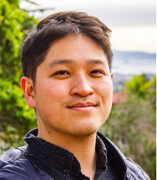
Andy Nguyen
Assistant Professor
Contact
Address:
4246 SES
Office Phone:
Email:
Related Sites:
About
Many of the current and future challenges that chemistry hopes to address require molecules of ever-increasing complexity. Our lab is guided not only by the structural and functional sophistication of biomolecules, but also by the way Nature uses the process of evolution to arrive at these molecules. We leverage the versatility of sequence-defined oligomers to build and evolve macromolecular inorganic complexes that function as efficient catalysts and molecular machines for energy conversion and drug delivery.
Multimetallic Chemistry
Multimetallic clusters are present in enzymes that perform remarkable small-molecule transformations, including carbon dioxide reduction, methane oxidation, and water oxidation. We are targeting macromolecular ligands to assemble cluster complexes that represent simplified yet accurate models of multimetallic enzyme active sites.
Supramolecular Cooperativity
Stimuli-responsive molecules are sought after for their ability to turn on function in response to specific signals. These molecules are useful in sensing and delivery. In biology, the phenomenon of cooperativity is programmed into stimuli-responsive proteins so that the specificity to the stimulus-of-interest is greatly enhanced (e.g. hemoglobin's behavior towards partial pressures of dioxygen). We are interested in building novel metal-containing supramolecular structures that exhibit cooperative behavior in response to different stimuli.
Evolvable Catalysts
Homogeneous metal complexes have proven to be powerful catalysts for numerous applications ranging from small-molecule transformation to organic synthesis. However, slight inaccuracies in "rational" design of catalysts can manifest as drastic reduction in catalysis rate and selectivity. We propose that applying the process of evolution to synthetic systems can lead to highly effective catalyst generation. Sequence-defined oligomers are ideal candidates to build such catalysts due to their modular and efficient assembly, while their sequence-defined nature facilitates the process of variation and selection.
Publications
13. “Stabilization of reactive Co4O4 cubane oxygen-evolution catalysts within porous frameworks” Nguyen, A. I.,* Van Allsburg, K. M.,* Terban, M. W., Bajdich, M., Oktawiec, J., Amtawong, J., Ziegler, M. S., Dombrowski, J. P., Lakshmi, K. V., Drisdell, W. S., Yano, J., Billinge, S. J. L., Tilley, T. D. Proc. Natl. Acad. Sci. U. S. A., 2019, 116, 11630-11639. *Equal contribution
12. “A Bio-Inspired Approach to Ligand Design: Folding Single-Chain Peptoid to Chelate a Multimetallic Cluster” Nguyen, A. I.; Spencer, R. K.; Anderson, C. L.; Zuckermann, R. N. Chem. Sci., 2018, 9, 8806-8813.
11. “Influence of a “Dangling” Co(II) Ion Bound to a [MnCo3O4] Oxo Cubane” Nguyen, A. I.; Darago, L. E.; Balcells, D.; Tilley, T. D. J. Am. Chem. Soc., 2018, 140, 9030-9033.
10. “Sequence-Dependent Self-Assembly and Structural Diversity of Islet Amyloid Polypeptide-Derived β-Sheet Fibrils” Wang, S–T.; Lin, Y.; Spencer, R. K.; Thomas, M. R.; Nguyen, A. I.; Amdursky, N.; Pashuck, E. T.; Skaalure, S. C.; Song, C. Y.; Parmar, P. A.; Morgan, R. M.; Ercius, P.; Aloni, S.; Zuckermann, R. N.; Stevens, M. M. ACS Nano, 2017, 11, 8579–8589.
9. “Artificial Metalloproteins Containing Co4O4 Active Sites” Olshansky, L.; Huerta-Lavorie, R.; Nguyen, A. I.; Vallapurackal, J.; Furst, A.; Tilley, T. D.; Borovik, A. S. J. Am. Chem. Soc. 2018, 140, 2739-2742.
8. “Manganese–Cobalt Oxido Cubanes Relevant to Manganese-Doped Water Oxidation Catalysts” Nguyen, A. I.; Suess, D. L. M.; Darago, L. E.; Oyala, P. H.; Levine, D. S.; Ziegler, M. S.; Britt, R. D.; Tilley, T. D. J. Am. Chem. Soc. 2017, 139, 5579-5587.
7. “Synthetic control and empirical prediction of redox potentials for Co4O4 cubanes over a 1.4 V range: implications for catalyst design and evaluation of high-valent intermediates in water oxidation” Nguyen, A. I.; Wang, J.; Levine, D. S.; Ziegler, M. S.; Tilley, T. D. Chem. Sci. 2017, 8, 4274-4284.
6. “Mechanistic Investigations of Water Oxidation by a Molecular Cobalt Oxide Analogue: Evidence for a Highly Oxidized Intermediate and Exclusive Terminal Oxo Participation” Nguyen, A. I.; Ziegler, M. S.; Oña-Burgos, P.; Sturzbecher-Hohne, M.; Kim, W.; Bellone, D. E.; Tilley, T. D. J. Am. Chem. Soc., 2015, 137, 12865-12872.
5. “Efficient C–H Bond Activations via O2 cleavage by a Dianionic Co(II) Complex” Nguyen, A. I.; Hadt, R. G.; Solomon, E. I.; Tilley, T. D. Chem. Sci. 2014, 5, 2874-2878.
4. “Designing Catalysts for Nitrene Transfer Using Early Transition Metals and Redox-Active Ligands” Heyduk, A. F.; Zarkesh, R. A.; Nguyen, A. I. Inorg. Chem. 2011, 50, 9849-9863.
3. “Catalytic Nitrene Transfer by a Zirconium(IV) Redox-Active Ligand Complex” Nguyen, A. I.; Zarkesh, R. A.; Lacy, D. C.; Thorson, M. K.; Heyduk, A. F. Chem. Sci., 2011, 2, 166-169.
2. "N-tert-butyl ortho-aminophenol, ortho-iminoquinone, and a zirconium(IV) bis(aminophenol) complex” Blackmore, K. J.; Nguyen, A. I.; Heyduk, A. F. Inorg. Synth., 2010, 35, 92-96.
1. “One- and Two- Electron Reactivity of a Tantalum(V) Complex with a Redox-Active Tris(amido) Ligand” Nguyen, A. I.; Blackmore, K. J.; Carter, S. M.; Zarkesh, R. A.; Heyduk, A. F. J. Am. Chem. Soc., 2009, 131, 3307-3316.
Education
Post Doc - Lawrence Berkeley National Laboratory
PhD 2016 - UC Berkeley
BS 2010 - UC Irvine